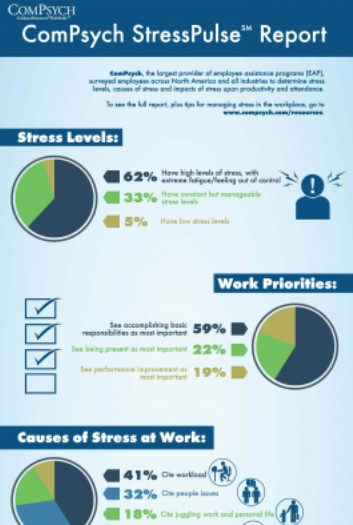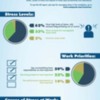Numerous studies show that job stress is far and away the major source of stress for American adults and that it has escalated progressively over the past few decades. Increased levels of job stress as assessed by the perception of having little control but lots of demands have been demonstrated to be associated with increased rates of heart attack, hypertension, and other disorders.
Digesting the Statistics of Workplace Stress
Numerous surveys and studies confirm that occupational pressures and fears are far and away the leading source of stress for American adults and that these have steadily increased over the past few decades. While there are tons of statistics to support these allegations, how significant they are, depends on such things as how the information was obtained (self-report vs. answers to carefully worded questions), the size and demographics of the targeted group, how participants were selected and who sponsored the study. Some self-serving polls claiming that a particular occupation is "the most stressful" are conducted by unions or organizations in an attempt to get higher wages or better benefits for their members. Others may be conducted to promote a product, such as the "Stress In the Nineties" survey by the maker of a deodorant that found housewives were under more stress than the CEOs of major corporations. Such a conclusion might be anticipated from telephone calls to residential phones conducted in the afternoon. It is crucial to keep all these caveats in mind when evaluating job stress statistics.
According to a Gallup poll, with global borders closing, workplaces shuttering and jobs being cut, workers' daily stress reached a record high, increasing from 38% in 2019 to 43% in 2020. Leaders and managers at every level should address this as it could lead to increased burnout, upset and disengagement.
COVID-19 Impact
45% of people say their own life has been affected "a lot" by the coronavirus situation. Although not surprising, leaders need to focus on employee engagement and wellbeing to build organizational resilience for tomorrow's workplace.

40+ WORRISOME WORKPLACE STRESS STATISTICS [2022]: FACTS, CAUSES, AND TRENDS
Research Summary. Workplace stress is one of the largest hurdles you can experience on the job. Stress at work comes in all shapes and sizes, across all types of industries and careers. After extensive research, our data analysis team concluded:
- 83% of US workers suffer from work-related stress, with 25% saying their job is the number one stressor in their lives.
- About one million Americans miss work each day because of stress.
- 76% of US workers report that workplace stress affects their personal relationships.
- Depression-induced absenteeism costs US businesses $51 billion a year, as well as an additional $26 billion in treatment costs.
To read more of the American Institute of Stress's article, please click here.



Comments (0)